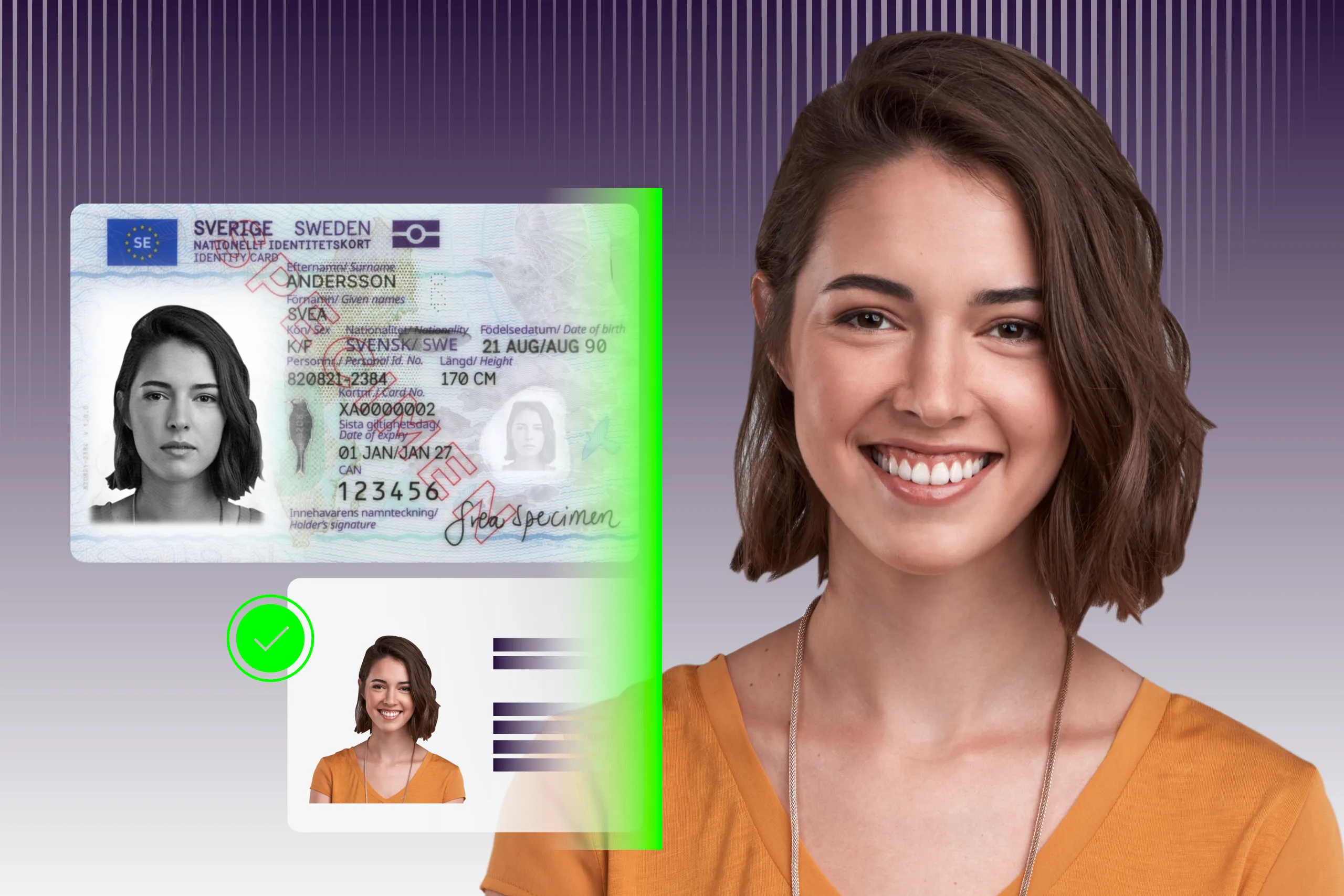Identity verification (IDV) is one of the critical security components for large events like conferences, music festivals, and pilgrimage gatherings, where thousands of attendees are involved. Managing IDV for such events requires complex infrastructure and often includes much manual work.
In this article, we explore how IDV plays a role in large-scale event management, highlighting the common challenges and the solutions that help address these issues effectively.
IDV for events: The process
Most event organizers verify attendee identities either during ticket purchase or upon entry to the venue. This process has both online and offline components. Let’s break it down:
Online: A user registers for the event by submitting personal details (name, address, mobile number, etc.) and sometimes their ID document and/or a selfie to confirm their identity and verify age. The system generates a ticket with unique attributes, such as a barcode or QR code.
Offline: The attendee presents their printed or electronic ticket to an attendant or walk-through system at the event. The ticket is verified manually or automatically. Additionally, the attendee’s identity can be confirmed through a face recognition system and/or ID document verification.
As you can see, various technologies, tools, and human agents are involved in the attendee verification process. To summarize, the entire flow includes three key stages:
| Attendee identification | Attendee verification | Attendee authentication |
|---|---|---|
This is John Doe | This is the legitimate John Doe, not a John Doe impersonator | This is John Doe from the list of known attendees |
During large-scale events, especially world sports championships, staff accreditation plays a major role. While it often resembles attendee authentication, the access and security elements are more critical. Organizers need to manage many behind-the-scenes aspects, such as controlling access to restricted areas and distributing meal vouchers. For this reason, staff accreditation can involve a more complex process with multiple checks.
To build a robust system, companies employ various technologies to streamline each stage using automation. Also, it’s essential to consider the specifics of the event.
Subscribe to receive a bi-weekly blog digest from Regula
Major IDV challenges in event management
The customer journey for event participants may seem straightforward. However, large-scale events like the FIFA World Cup or Eurovision Song Contest attract vast numbers of people from around the world, often requiring the involvement of third parties and impacting local daily routines.
With this in mind, let’s outline the main challenges event organizers face when it comes to verifying attendees’ identities:
Overloaded border checkpoints
International participants often need to verify their identity before reaching an event venue. During major events, passport control areas at airports and border checkpoints can become overcrowded.
For example, tourists from 80 countries visited Malmö, Sweden, in May 2024 for the Eurovision Song Contest. Some of these visitors required visas to enter the country.
With more travelers in line, the risk of illegal entry rises. As a result, countries must implement additional security measures and deploy extra personnel to maintain border security during big concerts, sports matches, etc.
Fraudsters lurking behind the scenes
Popular events with high traction often attract bad actors. Common tactics include scam registration sites that sell tickets which either never arrive or turn out to be fake, damaging the event's reputation.
Ticket scalping, where scammers resell tickets bought from legitimate sellers, causes both financial and reputational harm. In many cases, a single entry code or ticket is sold to multiple people. This creates confusion during attendee authentication, as it becomes difficult to identify the legitimate visitor among the fraud victims.
Additionally, there is a risk of impersonation at high-profile or private events, where entry passes intended for specific participants are misused.
Large amounts of personal data to store
Organizers process and collect various information about attendees for identification and authentication, including sensitive details such as residential addresses, phone numbers, and biometrics.
Typically, this data is used before and during the event, and should be deleted afterward. However, while it remains in the organizer’s database, the company must ensure its security, taking into account the risk of data breaches and other potential incidents.
Age verification component
While many age verification policies for events are more recommendations than strict rules, it’s essential for most organizers to prevent minors from attending events meant for adult audiences.
On the other hand, events like mass beer festivals must comply with laws governing the sale and supply of alcohol. As a result, organizers are required to include age verification in their attendee management systems.
Repetitive manual checks
At registration checkpoints, each attendee must be verified as a legitimate ticket holder. This task often falls to human agents who have to check visitors quickly and accurately.
However, managing the process can be challenging, as agents are often responsible for additional duties like issuing entry stamps or wristbands with specific access rights. This can lead to errors and cause frustration among attendees waiting in line.
Numerous participants in queues
Large-scale event organizers inevitably have to cope with queues at the venue entrance. Poor arrangements or delays can quickly escalate, turning an organized line of attendees into a growing crowd.
For example, the Waterbomb Hong Kong music festival faced public backlash due to long queues at the entrance. A one-hour delay caused by bad weather left some participants stuck outside even after the show had started. As a result, the organizers had to issue an apology, while photos and videos of the 500-meter-long queue went viral online.

Photo by Huang Baoying. Source: www.hk01.com.
Practical part: IDV solutions for global events
Let’s explore how companies can address the challenges of attendee verification at different stages.
Detailed registration forms
First, organizers must identify their users to ensure they are real individuals, not scammers or fakes. To achieve this, some events require participants to complete registration forms with personal details, including a photo. This approach is used by many business events like Gitex Global.

Gitex Global organizers request both identity and contact information during event registration.
This information can then be verified onsite during attendee authentication through photo ID checks.
An online option includes embedding an IDV solution into the platform or mobile app. When a new customer scans their identity document, the system authenticates it, ensuring the ID is genuine. Selfie identity verification ensures that the ID belongs to the person presenting it.
Additionally, automating data entry can streamline the online verification process for customers.
Smooth border crossing checks
Large events, particularly religious mass gatherings like Hajj in Saudi Arabia or Kumbh Mela in India, place significant pressure on local facilities and authorities, including the hospitality sector and law enforcement agencies.
However, during these mega-events, the border officers are on the front line. To handle the enormous surge in travelers, they must be equipped with specialized tools to complete border crossing procedures both quickly and thoroughly.
ID document readers allow passport control officers to effectively authenticate various travel documents and visas. With proper light sources and magnification, these tools ensure precise first-line document verification, reducing queues and detecting any inconsistencies in passports and ID cards.
Additionally, local authorities often increase border crossing capacity ahead of global events. For example, in 2024, Saudi Arabia equipped all ports with translation systems capable of handling 137 languages to streamline the entry process for over half a million pilgrims before Hajj.
Automated ticketing and access management
A major challenge for many event organizers is managing venue access on the day of the event. For large musical festivals, this can mean handling 12,000 people per day, like at Massif in Romania, or even over 100,000 people daily, as seen at Untold Dubai.
Netpositive, the event organizer, solves this task with automation. During these festivals, each ticket redemption point, where visitor tickets are checked and exchanged for wristbands, was equipped with multi-purpose mobile devices powered by a specialized app. Using the app, attendants verified passports, ID cards, and driver’s licenses from festivalgoers in mere seconds. Importantly, all personal data was stored on-site and deleted after the festival was over.
Age verification system
Mass events where age-restricted goods are available often must comply with local regulations for attendee age verification.
For instance, Oktoberfest Colchester in the UK operates under the "Challenge 25" system. This means a valid photo ID is required to prove age when entering the venue or purchasing drinks at the bar. Participants are also required to disclose their age during event registration.

Age submission is mandatory when buying a ticket for Oktoberfest Colchester.
Event personnel only approve adult visitors with the following valid and up-to-date IDs:
Passport with hologram (photocopies aren’t accepted)
Military ID with a visible date of birth
Age verification can also be automated. IDV solutions used for attendee authentication can read age-related information from presented ID documents and match the holder’s portrait with their selfie taken at the entry point.
Partner with Regula for effective event collaboration
IDV may not be front and center, but it’s an important part of event management. Global events attract thousands of people from around the world, along with fraudsters trying to bypass defenses to pursue illegal goals.
Regula provides advanced technologies and tools to help manage large events smoothly and securely:
Software solutions: Regula Document Reader SDK verifies a wide range of identity documents from around the world, while Regula Face SDK ensures biometric authentication through face recognition.
Hardware solutions: First-line document readers are designed for seamless onsite authenticity checks.
Knowledge database: The most comprehensive database in the world, featuring over 16,000 identity document templates from 254 countries and territories.
100% on-premises: Regula’s solutions can be deployed on a client’s infrastructure, ensuring the security and integrity of attendee data.
Let’s talk business!





